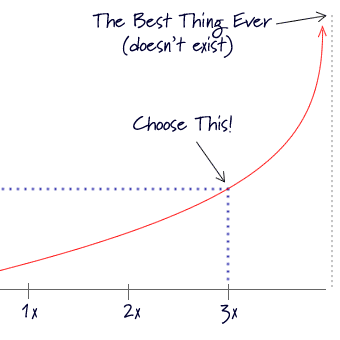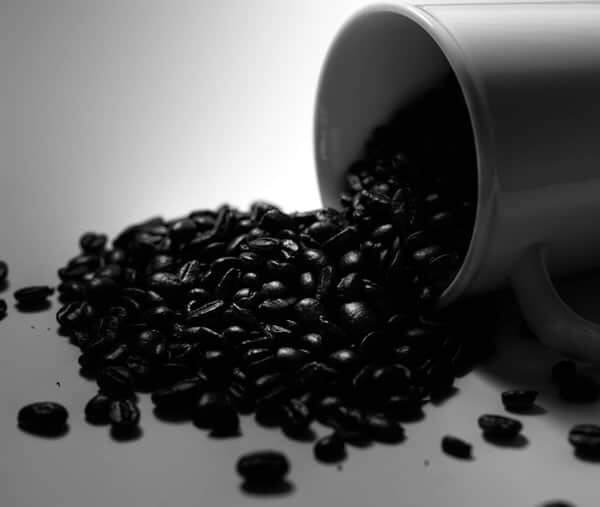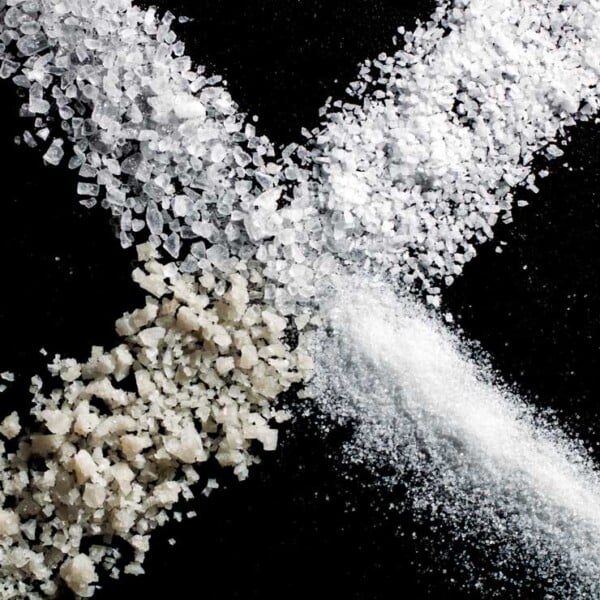Is “MyPlate” a step in the right direction?
Jun 02, 2011, Updated Sep 20, 2018
![]()
This morning the USDA unveiled their new food icon, a simple plate graphic that (finally) replaces the confusing and cumbersome “My Pyramid” [PDF]. Twitter has been all aflutter (#myplate and #foodicon) with rants, raves, praises, and a fare share of criticism. Love it or hate it, this is clearly an important and much-needed change.
The new graphic is a huge improvement. It’s clear, concise, and doesn’t require much knowledge or training to understand how to apply, at least on the most basic levels. (The most recent “My Pyramid” required a mind-numbing getting started guide [PDF] with worksheets, charts, and tables — thus rendering it effectively useless.)
I do love that it shows a plate — which I hope will encourage people to start using again, rather than eating out of containers, cardboard boxes, and bags. (It’s a sad state of affairs that this is a significant concern, but, well, it is).
However, the plate icon is far from perfect, and it is by no means revolutionary. By necessity, it is a simplistic icon, and by its very nature it cannot accomplish or communicate everything it needs to.
It’s also pretty much the same advice we’ve been hearing for years. In the 1970s we were told to eat four food groups: Milk, Meat, Vegetable & Fruit, and Bread & Cereal. With the rates of overweight and obesity skyrocketing, clearly that advice — even if well-intentioned and fundamentally accurate — isn’t working so well right now.
I certainly welcome the change from “meat” to “protein,” and am happy that vegetables and fruits are each their own group — and therefore make up 40% of the recommended categories. I do, however, wish that dairy was grouped in with “protein,” which would be both more accurate and less confusing (ice cream is included in “dairy,” as you’ll see below).
But here’s where it gets a little odd. As listed prominently on the ChooseMyPlate.gov homepage, the plate icon is meant to encapsulate seven key ideas. From a purely graphical standpoint, the plate communicates just one of them, so if these are the seven most important messages the American Public needs to hear, then the MyPlate is an utter failure.
(We can debate the merits of the seven ideas another time.)
1. “Enjoy your food, but eat less” and 2. “Avoid oversized portions.”
I realize that this is a drawing that needs to work in a variety of sizes and in different mediums (print, web, t-shirts, etc.), and that’s fine. But I’m having a hard time finding any “joy” in this simplistic diagram. I also see no reference to “eat less,” except perhaps that the fork helps provide a sense of scale.
A larger plate generally means you’ll eat more food, but there’s no real indication of the size of the plate in this illustration. As for the oversized portions, again, without a sense of scale, this message does not come through. Additionally, many foods can’t be separated into these four distinct categories, as they’re often combinations of these groupings. How does that fit into this plate?
3. “Make at least half your plate fruits and vegetables.”
This is the only one that’s conveyed perfectly. I also like the suggestion of having slightly more vegetables than fruits.
4. “Make at least half your grains whole grains.”
A laudable goal, but they completely struck out on this one. The plate just says “Grains.” No indication of any kind about whole grains vs. refined. Even wonderbread would meet the criteria!
5. “Switch to fat-free or low-fat (1%) milk.”
Wait, what? First of all, they’re assuming that people are drinking milk with their meals, and then making the assumption that they’re drinking 2% or whole (3.3%) milk. If you dig a little deeper, the “dairy” circle includes soy milk and other milk substitutes… but is also includes “milk-based desserts,” like puddings and ice cream.
Sidenote: Considering there aren’t lobbying agencies for the four other food groups (there’s no “protein” lobby, as far as I know, and the closest thing Grains have is the Whole Grains Council), it’s painfully obvious why dairy gets its own category. Thanks, food politics!
6. “Compare sodium in foods like soup, bread, and frozen meals — and choose the foods with lower numbers.”
There’s no mention — or even hint — of sodium on the plate. Another missed opportunity.
7. “Drink water instead of sugary drinks.”
Umm, the plate shows a glass of milk, not water. Milk contains a lot of (naturally-occurring) sugar on its own, so that is inherently conflicting. More importantly, though, considering how much chocolate milk is served (and consumed) in schools and elsewhere — which has an enormous amount of added sugar — this is a significant contradiction.
The real question
During the press conference this morning, there were several mentions of how this plate is just the beginning of improving our food system, and I am encouraged by this. The real question, now, is whether or not we will be going beyond rhetoric. Is this the start of real, systemic change from our government?
The USDA suggests filling 50% of the plate with fruit and vegetables, but less than 1% of federal agricultural subsidies go towards fresh fruit and vegetables (the vast majority of subsidies go to corn, eventually resulting in inexpensive meat, processed foods, and sugary beverages).
As I’ve written recently, the single biggest way we can improve our food system in this country — and with it the health of all Americans — is to change our agricultural subsidies to truly reflect our science-based (not industry-lobby-based) understanding of diet and nutrition.
Ultimately, I hope that this icon is a symbol of real change to come, and not just another rebranding of the same old, tired food groups.
—
Update — Here are some other excellent articles that are worth the read:
USDA’s “Dinner Plate” vs. Farm Subsidies: It’s Still No Contest (Melanie Warner)
My Plate: New Illustration, Same Problems (Andy Bellatti)
Why we need MyPolicy instead of MyPlate (Michele Simon)
—
What are your thoughts on the new MyPlate? Is it an improvement? A waste of $2 million to develop and promote it? Sound off!




















Anyone really have the answer to: When the guidelines say your nutritional diet should be 40% fruits and vegetables, do they mean in calories or quantity? And if the latter, is it by weight or by volume?
So, how is one to know how much 40% really means.
Okay, it is a step in the right direction, but if one really wanted to follow it, what are the amounts?
One of the seven key message is to “Make at least half your plate fruits and vegetables.” My take is that they’re talking about volume, not calories. (And the “dairy” group is considered discretionary, or optional. So by volume we could be talking about 50%, not 40%, if you ignore dairy, or decide to group together dairy and protein in the same category, which I prefer.) I do like that these guidelines are getting away from calorie counting — which people hate, and which also turns food into a joyless number. Here’s the 4-page PDF executive summary of the 2010 Dietary Guidelines. Worth the read. Additionally, the Choose My Plate website does have quite a lot of detail and excellent recommendations. Overall, I think the 2010 guidelines are a tremendous step forward. The bigger point I was making in this post, however, was that the plate doesn’t do a good… Read more »
I’m with Mrs Q – I wish I wrote this!
my favorite aspect was #3 also, at least half your plate = fruit + vegetables.
Thanks, Kristina! #3 is by far my favorite, too… and, I have to admit, is something I’m still working on myself.
The plate makes since. We had the same visual in a local ladies meeting a few years ago. When we look at what we are seeing on our plate, we should see similar portions. I agree with muc of what you said, especially about getting the agriculture on board. It is reasonable to me to expect people to eat more fruits and vegetables. These are the foods that support our immune sytem. Is it any wonder we have so many autoimmune diseases prevalent, particularly cancers. Some grains/beans combinations can make a complete protein. We could even use less meat. Sad it costs so much. But it may get us thinking.
Yes!
I do wish it said “Proteins” (plural) instead of “Protein.” That would help imply that there are more options than just “meat” for that slice of the plate (and would be consistent with all the other plurals on the plate.)
What’s the point of making the plate smaller if you’re going to add a second plate? Uhh… we made the plate smaller, but then we couldn’t fit all the food on it. Oh well, just add another plate for dairy. Make is a large slice of cheesecake sized plate. Now food makers just need to get with the program and add “good source of protein” to the frozen pizza box, and we can eat pizza, cake and chocolate milk for every meal and get super healthy. I also noticed that they got rid of the guy running up the hill. Maybe the redo will have the plate holding a shake weight. Haha
You crack me up, Derek! (and make some excellent points… It’s only a matter of time before we start seeing this icon on frozen pizza, lucky charms, and the like… ugh.)
I think it is a step in the right direction. It makes it easier for those people who are looking for answers and don’t understand or don’t know where to go to find nutrition information. I agree that people either are going to do it or not. The main point is to try and give people something to go by. We have been using a 9 inch plate that had the same concept for my daughters weight Mgmt. Program and I’m sure other nutrition programs were already using the concept as well.
Agreed! I think a very common complaint (self included) is that life is so complicated these days, that anything we can do to simplify is welcomed with open arms. They did pare the icon down to “the essentials.” I don’t think it’s going to change the entire system, but it does feel now like a useful tool to those who want it (unlike the 2005 pyramid).
If you really think about it, how many people really would be willing (able?) to eat almost half of their entire diet just fruits and vegetables? Come on now? (And is that in calories or quantity? Thank you Joan for that question.) It’s an unrealistic goal.
It’s only unrealistic because everything in our food culture — which is deeply rooted, from the family table to advertising to government subsidies — is geared against making this a reality.
As I mentioned at the end of the post, right now less than 1% of subsidies go towards whole, fresh fruits and vegetables. If the subsidies shifted so that we subsidized these to the same degree we subsidized corn and soybeans, we’d be seeing a huge shift. Fruit and veggie prices would go down considerably, junk food prices would go up considerably, and there would be an enormous change in our priorities.
It’s a two million dollar baby step in the right direction. Knowing our government, they will spend an additional five million dollars to get it right the second time.
Ha! True that. Realistically speaking, $2 million is completely inconsequential. It’s the equivalent of that penny I didn’t bother to pick up off the sidewalk. Same goes for $5 million… and if that’s all it costs to get it right, I’d be thrilled.
Very informative! Children are most likely to follow this food pyramid but most canteen now serves a non-nutritional/cheaper/ junk foods to children even in school.
-Philippines
Yes, you make an excellent point. Unless our entire “food system” (food culture?) is geared towards making this plate a reality, a visual aid such as this plate can only do so much… (which is to say, not much.)
I could not agree with you more. A well balanced diet is one of the most important things for health right next to exercise. I am A chiropractor and talk to people all the time about healthy eating habits. Defiantly keeping this site in my fav tab. Thanks so much for the great content. Take care.
For all the reasons you cite, and more, this is close to meaningless. Does one really think that this overly simplistic labeling will have any effect on those who need to modify their eating? Maybe it’ll raise some awareness, but I doubt it will have any practical impact. Those who know and do, will; those who don’t, still won’t.
I’m not sure I’d call it “close to meaningless.” Since it’s launch last week, I’ve actually found myself comparing my own dinner plate to the visual of the icon. For example, I’ve asked myself, “Could I have more veggies here, and maybe a little less fish?” In that regard, it’s actually helped clarify my focus a little bit, and has been an excellent reminder of areas which I can improve (granted, I already knew all of this, so it’s not revolutionary…but it’s definitely been more impactful for me than a “pyramid!”)
I wish I wrote this! You are right on!
Wow, that’s probably the nicest compliment anyone could ever give me. Thanks, Q! 🙂